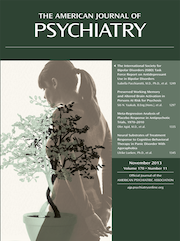T
o the E
ditor: Drs. Grzeskowiak and Morrison suggested conducting sex-specific analyses to augment our findings (
1). These investigators reported that fetal exposure to selective serotonin reuptake inhibitors (SSRIs) was associated with a significantly lower risk for girls who were overweight at ages 4 or 5 years compared with girls exposed prenatally to maternal psychiatric illness or to neither illness nor SSRI (
2).
Were any sex differences observed with respect to the impact of SSRI exposure on growth? The impact of fetal exposure to SSRI, major depressive disorder, or neither was modeled for male and female infants with longitudinal mixed-effect regression analyses. No significant associations were found in male infants (weight, p=0.37; length, p=0.27; or head circumference, p=0.63) or in female infants (weight, p=0.53; length, p=0.07; or head circumference, p=0.54).
Did weight-for-length-adjusted percentiles from international standards for growth at either extreme differ by sex? We evaluated the proportion of male and female infants at the <15th and >85th percentiles for weight-for-recumbent length according to both Centers for Disease Control and Prevention (CDC) and World Health Organization (WHO) standards. In 2010, the CDC convened with representatives from NIH and the American Association of Pediatrics and recommended WHO standards for children from birth through 2 years (
http://www.cdc.gov/growthcharts/who_charts.htm). The WHO standards reflect growth patterns among predominantly breastfed children and were designed specifically to create growth standards for children under optimal conditions.
Utilizing the CDC standards, the proportions of male infants at the <15th percentile or the >85th percentile did not differ by exposure. Similarly, no difference by exposure was observed for female infants. According to WHO standards, the proportions of male infants at the <15th and the >85th percentiles did not differ by exposure. However, a significant difference was identified for female infants at the <15th percentile. At birth, female infants exposed prenatally to major depressive disorder were more likely to be at the <15th percentile for weight-for-length (p=0.039) than female infants exposed to either SSRI or neither (58% compared with 17% compared with 36%, respectively). However, by 12 weeks old, the proportions of female infants in all groups were approximately 15%. No difference in female infants for the >85th percentile was observed.
Our findings and study design differ from those of Grzeskowiak et al. (
2). Our prospective investigation had a relatively small sample size, but it incorporated detailed exposure information, including laboratory documentation of SSRI exposure, diagnostic interviews for major depressive disorder, and urine drug screens. Grzeskowiak and colleagues’ retrospective study of a larger cohort was based on dispensed prescriptions for SSRI in women with unspecified psychiatric illness. Our data span the first year of life compared with their findings at ages 4–5 years. We look forward to this evolving literature.

